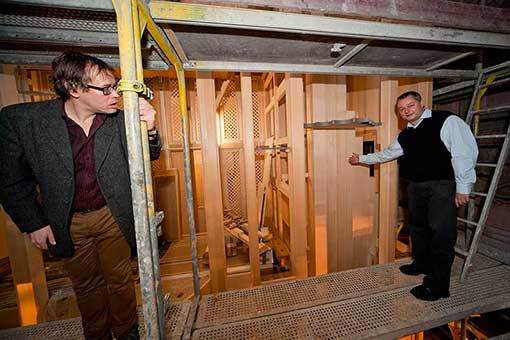Even in musical life things happen that cannot be heard even though it may seem like nonsense. But before the music resounds, something must be done for it, and in the case of an organ concert, it is mainly necessary to build the organ. In October, we published an interview with Jan Martin Bejček about the fact that there will be a new, high-quality instrument in Brno and now we return to the topic. The reason is simple – the organ is already here.
If we resort to the terminology of the motoring show Top Gear, it is not a luxury limousine or a tuned-up sports car, but a solid upper middle class car. It will not win the race for the highest number of cylinders – actually pipes – but it will comfortably fit a whole family of musical periods from old music until today, it will work reliably, it will not disturb its surroundings and it should also last long. After the final inspection, the whole complex machine was brought to Brno on 26 November and it is currently being installed in the choir of the church of the Assumption of the Virgin Mary – in Brno slang, in the "Jesuit Church", on Beethovenova street right next to Český rozhlas.
When you look at the organ now, when it is not yet finished, at first glance you will notice the perfect wood from which the pipes are made. I don’t think that any of us have seen such a surface without knots and blemishes for a long time. It is good to sometimes realise the quality of the materials of which musical instruments are made and what it is about them that costs so much money. Wood is wood, however, a mere dead matter, human labour is still the most expensive and most valuable. The spirit that drives the construction forward is priceless.
The basic material is spruce wood, which is used when painting is expected. Only the most stressed parts, for which the soft spruce wood would not be enough, are made of oak, beech, walnut... You will hardly see the new Brno organ revealed like this again, the natural material will be covered by the finishes. The instrument must fit into the Baroque church not only in terms of acoustics but also in terms of appearance.
The organ for Brno will have the city logo on the music stand but even the names of individual registers refer to the city. There are a total of forty-eight of them and they are divided into three manuals and a pedal. Registers of the first manual bear the names of Jesuit saints – among them St. Ignatius of Loyola, as well as Edmund Campion, who gave his name to the whole project. The second manual refers to the significant Jesuits associated with Brno. Among them is Bohuslav Balbín, known for his Discourse to Defend the Slavic Languages, especially Czech, who studied here, poet Bedřich Bridel and theologian and historian Martin Středa, whose name is associated with the siege of Brno by the Swedes. The third manual and pedal are devoted to significant Brno musicians led by Pavel Křížkovský and his famous student Leoš Janáček.
The organ is mechanical and works on a principle proven for centuries. Additional electronics are commonplace today, but not the essence of the instrument. Old music can be played on it well but it is not a replica of a historic organ. It is a contemporary, original machine. The author of the organ design is J. M. Bejček, the first phase of the project began in 2006–2007. The organ itself is the work of the Swiss firm Mathis Orgelbau – it is the first instrument built by the company in the Czech Republic.
The entire project is sponsored by the Campianus Endowment Fund; the entire construction budget is CZK 36 million including VAT. In addition to the help of God, however, the help of man is necessary. The organ is a symbol of the human community, and if you want to become a closer part of it, you have the option to adopt one or more pipes. You can choose a specific name and tone, the whole register, as you please; an overview of the adoption procedure is also available. Leoš Janáček is already sold but there are other personalities. Their names may have not circled the world but many of us went to an art school named after Jaroslav Kvapil and they still go to concerts at Musilka today. All the names of the registers are worthy of your attention and thanks to the project of the Organ of St. Edmund Campion, it will not remain forgotten.































